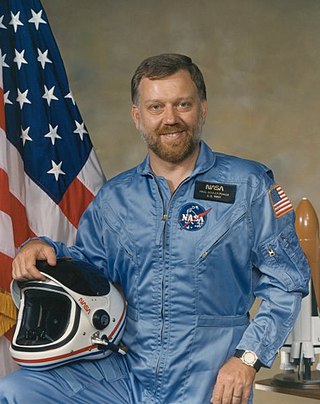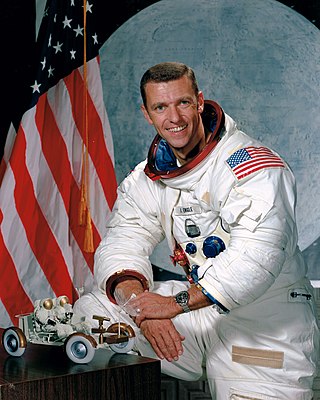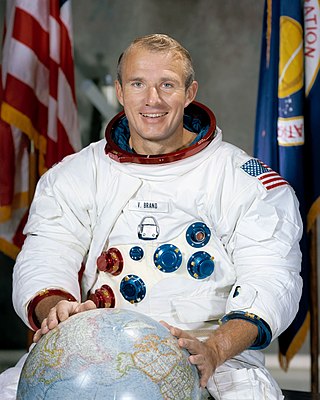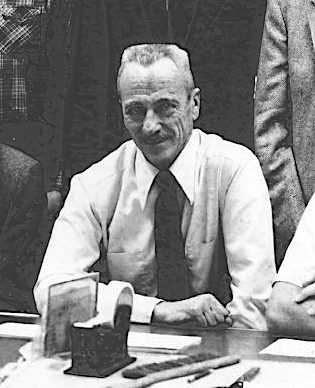Related Research Articles

Skywarn is a program of the National Weather Service (NWS). Its mission is to collect reports of localized severe weather in the United States. These reports are used to aid forecasters in issuing and verifying severe weather watches and warnings and to improve the forecasting and warning processes and the tools used to collect meteorological data. Reports are also used by local emergency managers and public safety organizations.

The Lyndon B. Johnson Space Center (JSC) is NASA's center for human spaceflight in Houston, Texas, where human spaceflight training, research, and flight control are conducted. It was renamed in honor of the late U.S. president and Texas native, Lyndon B. Johnson, by an act of the United States Senate on February 19, 1973.

Fred Wallace Haise Jr. is an American former NASA astronaut, engineer, fighter pilot with the U.S. Marine Corps and U.S. Air Force, and a test pilot. He is one of 24 people known to have flown to the Moon, having flown as Lunar Module pilot on Apollo 13. He was slated to become the 6th person to walk on the Moon, but the Apollo 13 landing mission was aborted en route.

James Donald "Wxb" Wetherbee, is a retired United States Navy officer and aviator, test pilot, aerospace engineer, and NASA astronaut. He is a veteran of six Space Shuttle missions and is the only American to have commanded five spaceflight missions.

STS-51-C was the 15th flight of NASA's Space Shuttle program, and the third flight of Space Shuttle Discovery. It launched on January 24, 1985, and made the fourth shuttle landing at the Shuttle Landing Facility at the Kennedy Space Center in Florida on January 27, 1985. STS-51-C was the first shuttle mission dedicated to the United States Department of Defense (DoD), and consequently many details remain classified. NASA reported that a satellite (USA-8) was deployed during the mission using an Inertial Upper Stage booster was deployed and met mission objectives. At just over three days, the mission was shorter in duration than most civilian missions and was the shortest of Discovery's career.

Henry Warren Hartsfield Jr. was a United States Air Force Colonel and NASA astronaut who logged over 480 hours in space. He was inducted into the United States Astronaut Hall of Fame in 2006.

Paul Desmond Scully-Power, AM GOSE FRAeS is an Australian-born American oceanographer, technology expert, business executive and astronaut. In 1984, while a civilian employee of the United States Naval Undersea Warfare Center, he flew aboard NASA Space Shuttle mission STS-41-G as a Payload Specialist. He was the first Australian-born person to journey into space, and the first astronaut with a beard.

Karol Joseph "Bo" Bobko was an American aerospace engineer, U.S. Air Force officer, test pilot, and a USAF and NASA astronaut. Bobko was the first graduate of the U.S. Air Force Academy to travel in space and the first person to fly on three different space shuttles across three different missions: STS-6, STS-51-D, STS-51-J.

Joe Henry Engle was an American pilot, aeronautical engineer, and NASA astronaut. He was the commander of two Space Shuttle missions including STS-2 in 1981, the program's second orbital flight. He also flew two flights in the Shuttle program's 1977 Approach and Landing Tests. Engle was one of twelve pilots who flew the North American X-15, an experimental spaceplane jointly operated by the Air Force and NASA.

Vance DeVoe Brand is a retired American naval officer, aviator, aeronautical engineer, test pilot, and NASA astronaut. He served as command module pilot during the first U.S.-Soviet joint spaceflight in 1975, and as commander of three Space Shuttle missions.

Robert Franklyn "Bob" Overmyer was an American test pilot, naval aviator, aeronautical engineer, physicist, United States Marine Corps officer, and USAF/NASA astronaut. Overmyer was selected by the Air Force as an astronaut for its Manned Orbiting Laboratory in 1966. Upon cancellation of the program in 1969, he became a NASA astronaut and served support crew duties for the Apollo program, Skylab program, and Apollo-Soyuz Test Project. In 1976, he was assigned to the Space Shuttle program and flew as pilot on STS-5 in 1982 and as commander on STS-51-B in 1985. He was selected as a lead investigator into the Space Shuttle Challenger disaster in 1986, retiring from NASA that same year. A decade later, Overmyer died while testing the Cirrus VK-30 homebuilt aircraft.

Richard Oswalt Covey is a retired United States Air Force officer, former NASA astronaut, and a member of the United States Astronaut Hall of Fame.

Patrick Graham Forrester is a NASA astronaut, engineer, and former Chief of the Astronaut Office. He is a retired United States Army colonel and Army aviator. He is married and has two children.

The Space Weather Prediction Center (SWPC), named the Space Environment Center (SEC) until 2007, is a laboratory and service center of the US National Weather Service (NWS), part of the National Oceanic and Atmospheric Administration (NOAA), located in Boulder, Colorado. SWPC continually monitors and forecasts Earth's space environment, providing solar-terrestrial information. SWPC is the official source of space weather alerts and warnings for the United States.

Gregory Carl "Ray J" Johnson, , is a retired American naval officer and naval aviator, test pilot, aerospace engineer, and NASA astronaut. He spent his military career in both the regular United States Navy and the Navy Reserve. Johnson was the pilot on Space Shuttle mission STS-125, the final Hubble Space Telescope servicing mission.

Michael Reed Barratt is an American physician and a NASA astronaut. Board certified in internal and aerospace medicine, he served as a flight surgeon for NASA before his selection as an astronaut and has played a role in developing NASA's space medicine programs for both the Shuttle–Mir program and International Space Station. His first spaceflight was a long-duration mission to the International Space Station as a flight engineer on the Expedition 19 and 20 crew. In March 2011, Barratt completed his second spaceflight as a crew member of STS-133. Barratt made a second long-duration mission to the International Space Station as a flight engineer on the Expedition 70, 71, and 72 crew and also served as the pilot on the SpaceX Crew-8 mission.

Joseph G. Galway, was an American meteorologist pioneering in the fields of severe convective storm forecasting and research. He was one of the first forecasters for the Severe Local Storms Unit and the National Severe Storms Forecast Center, and developed widely used synoptic predictors associated with severe thunderstorms and tornadoes, such as the jet streak and lifted index.

45th Weather Squadron, 45th Operations Group, Space Launch Delta 45, at Patrick Space Force Base, Florida performs weather assessments for air and space operations; specifically, weather observations, forecasts, advisories, and warnings. It specialized in the weather assessments for the Space Shuttle launches at Kennedy Space Center (KSC) and Cape Canaveral Space Force Station.

James Milton Heflin Jr. is a retired NASA official, who recently served as the associate director for technical activities at Johnson Space Center in Houston. Heflin also served as lead flight director for seven high-profile Space Shuttle missions, including the first to service and repair the Hubble Space Telescope and three that deployed inter-planetary probes.

Weather reconnaissance is the acquisition of weather data used for research and planning. Typically the term reconnaissance refers to observing weather from the air, as opposed to the ground.
References
- ↑ "SMG and Space Program Mission, History, and Information". Spaceflight Meteorology Group. 3 Oct 2011. Retrieved 2012-01-24.
- ↑ "Frequently Asked Questions". Spaceflight Meteorology Group. 8 Oct 2002. Retrieved 2012-01-24.
- ↑ Brody, Frank C.; R.A. Lafosse; D.G. Bellue; T.D. Oram (Sep 1997). "Operations of the National Weather Service Spaceflight Meteorology Group". Weather Forecast. 12 (3): 526–44. Bibcode:1997WtFor..12..526B. doi: 10.1175/1520-0434(1997)012<0526:OOTNWS>2.0.CO;2 . ISSN 1520-0434.
- ↑ Oram, Timothy (Jan 2008). "NWS Spaceflight Meteorology Group Support for the NASA Constellation Orion Vehicle". 13th Conference on Aviation, Range and Aerospace Meteorology. New Orleans, LA: American Meteorological Society.
- ↑ "Spaceflight Meteorology Group Forecasters To Face Bold New Challenges". National Weather Service. 2011-08-15. Retrieved 2012-01-16.
- ↑ Oram, T.D. (May 2002). "Verification of world-wide space station emergency landing forecasts - Challenges and results" (PDF). 10th Conference on Aviation, Range, and Aerospace Meteorology. Portland, OR: American Meteorological Society. pp. 186–8.